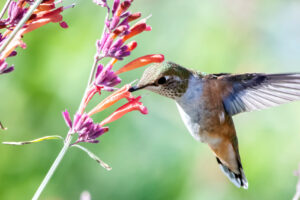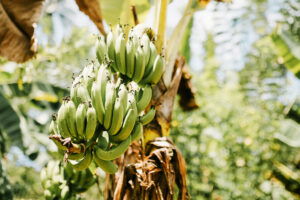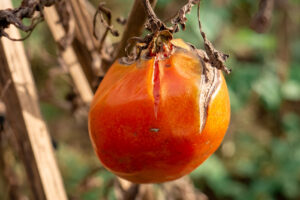During the month of July 1969, American astronauts landed on the moon, forever demystifying the celestial timekeeper that had long influenced agriculture. With one “giant leap for mankind,” the mysterious orb, whose cyclical phases had been used to track the passage of days, months, and seasons, often influencing agricultural planning, lost its ancient god-like status. So, July seems like a good time to explore whatever modern influence the moon might still possess.
In permaculture, where observation and working with nature are core principles, does the potential impact of the moon on gardening have any validity? While modern agriculture often dismisses lunar rhythms as unimportant, ancient cultures saw the moon as a powerful authority on the timing of planting and harvesting. Even the Farmer’s Almanac (established in 1792) has long used moon phases to guide gardening advice. This practice is based on traditional beliefs and folk wisdom rather than modern science, but many gardeners swear by it.

Folk Traditions from Around the World
Many Indigenous and folk cultures have used lunar calendars for generations to guide agricultural activities:
- Native American tribes traditionally timed corn, bean, and squash plantings to moon phases.
- In Europe, moon planting folklore included sayings like “plant potatoes during the dark of the moon.”
- In Asian cultures, rice and root crop sowing are aligned with waning or waxing cycles. The lunar calendar is also used to guide tea harvesting.
- Ancient Egyptians: Timed planting and harvesting by the heliacal rising of Sirius and phases of the moon.
- Babylonians: Created detailed lunar calendars for planting and animal breeding.
- Ancient Greeks and Romans
Pliny the Elder (a Roman author, naturalist, and military commander) recorded agricultural wisdom linking lunar phases to sowing and harvesting. The day of the moon, Monday, was considered favorable for planting leafy greens. Greek farmers believed the moon influenced moisture in the soil, echoing the moon’s control over tides.

Why It Made Sense Then
Even without modern scientific proof, ancient people recognized that lunar gardening became a practical and spiritual guide — a means of being in rhythm with nature. Plants seemed to sprout faster when sown during certain moon phases. Moisture levels and insect activity often correlated with the lunar cycle.
Does the Moon Matter in Permaculture?
Permaculture emphasizes working with natural systems rather than against them. The moon, as a natural regulator of tides, sap flow, moisture, and biological rhythms, plays a significant role in the Earth’s ecosystems. Just as the moon governs ocean tides, its gravitational pull subtly affects soil moisture, seed germination, and plant vitality.
Lunar influence on water and sap flow
- Like ocean tides, plant sap and groundwater may be influenced by the moon’s gravitational pull.
- Some studies in forestry and viticulture suggest that tree sap rises during a waxing moon and lowers during waning, influencing harvesting quality (wood density, wine grapes).
- Source example: Holzner et al., 2018, in viticulture
Circadian and lunar rhythms in plants
- Plants have internal clocks (circadian rhythms) that can be influenced by light/dark cycles — and in some cases, moonlight.
- Studies show some algae and flowering plants respond to lunar illumination or night length in flowering or spore release.
If you’re interested in experimenting, try keeping a moon gardening journal to track what works. While science may be slow to embrace lunar influence in gardening, observational wisdom often holds surprising value — especially in permaculture.
How the Moon Affects Groundwater in Florida
1. Tidal Influence on Coastal Aquifers
- In coastal zones, the gravity of the moon causes tides, which can influence the pressure and level of groundwater in adjacent aquifers.
- The surficial aquifer and parts of the Floridan aquifer near the coast can experience cyclical fluctuations in water levels corresponding with lunar cycles (especially spring tides during new and full moons).
2. Barometric Pressure Changes
- Lunar phases affect atmospheric tides, which influence barometric pressure.
- Fluctuations in pressure can affect water table height, especially in shallow systems.
- Lower barometric pressure (often associated with full/new moon periods) allows groundwater to rise slightly.
3. Earth Tides and Aquifer Stress
- The gravitational pull of the moon causes not just ocean tides, but “Earth tides”—the solid earth actually expands and contracts a few inches.
- This can affect deep aquifers by slightly compressing or relaxing them, changing hydraulic head and flow.
- Studies in Florida and other karst regions have shown measurable, cyclic fluctuations in groundwater pressure and flow tied to lunar phases.
Relevance to Gardening & Permaculture
While moon effects on groundwater are real, the impact on daily gardening is usually negligible — unless you’re:
- Tapping shallow wells
- Observing spring-fed water features
- Designing a system that relies on tidal inflow or water table dynamics

The Four Primary Moon Phases and Their Gardening Influence
The lunar month is divided into four primary phases: New Moon, First Quarter, Full Moon, and Last Quarter. Each phase correlates with particular energies that can inform permaculture practices.
1. New Moon (Waxing Crescent)
- Energy: A time of initiation and potential
- Best for: Leafy greens, lettuce, spinach, herbs
- Why: The gravitational pull is strong, but moonlight is increasing, encouraging balanced root and leaf growth
In folk traditions, this is a time of sowing intentions and planting crops that grow above ground with quick harvest cycles.
2. First Quarter (Waxing Gibbous)
- Energy: Growth, momentum, upward expansion
- Best for: Fruit-bearing annuals like tomatoes, squash, and beans
- Why: Moonlight and gravitational energy are both increasing, favoring strong foliage and flowering
This phase supports permaculture designs focused on expansion: planting new polycultures, guilds, or expanding your food forest.
3. Full Moon
- Energy: Peak vitality and high moisture
- Best for: Harvesting, transplanting, and fruiting crops
- Why: Sap flow is at its peak, making this an ideal time for harvesting juicy, nutrient-dense produce
Biodynamic calendars often highlight the full moon as a key moment for observation, ritual, and alignment with the land.
4. Last Quarter (Waning Moon)
- Energy: Releasing, composting, and resting
- Best for: Root crops (carrots, beets), pruning, weeding
- Why: The gravitational pull is decreasing, encouraging roots to settle deeply into the soil
This time could be used to reflect, observe patterns, and engage in restorative tasks like mulching or compost management.
Plants Affected by the Moon
While all plants are technically influenced by the natural cycles of light, gravity, and moisture, some are more noticeably affected by the moon, especially in their germination, growth, flowering, or sap flow. These effects can be subtle, but they are most observable in:
1. Fast-Growing Annuals (Sensitive to Moisture and Light)
These plants respond quickly to environmental changes like soil moisture and subtle lunar gravity shifts:
- Leafy greens: lettuce, spinach, arugula
- Legumes: beans, peas
- Brassicas: cabbage, kale, broccoli
- Corn (especially in traditional maize-based cultures)
These are often recommended to be planted during the waxing moon, when sap and moisture are said to rise.

2. Night-Blooming Plants (Sensitive to Moonlight)
These plants are clearly affected by moonlight intensity and night rhythms:
- Moonflower (Ipomoea alba) – blooms at dusk, often more intensely near the full moon
- Queen of the Night / Dragonflower (Epiphyllum oxypetalum) – blooms only at night, sometimes aligning with the full moon
- Night-blooming jasmine (Cestrum nocturnum)
- Evening primrose (Oenothera)
These may be influenced by lunar light cues, which guide their bloom timing and pollinator attraction.

3. Trees (Affected by Lunar Gravity and Sap Flow)
Some evidence suggests trees experience sap fluctuations with moon cycles, especially in biodynamic and indigenous practices:
- Fruit trees: apples, pears, stone fruits
- Timber trees: mahogany, teak, eucalyptus, pine
- Rubber trees & maples – tapped during specific moon phases for higher yield or quality
Many indigenous groups (including in the Amazon) harvest wood during a waning or full moon when the sap is lower, making the wood more durable.
4. Root Crops (Thought to Thrive During Waning Moon)
Folklore and biodynamic calendars suggest that planting during the waning moon benefits underground crops:
- Carrots
- Beets
- Potatoes
- Onions and garlic
- Turnips and radishes
The idea is that lunar gravity pulls moisture deeper into the soil, supporting root development.
Plants In Sync With The Moon
While not scientifically proven for all species, many night-blooming plants appear to synchronize blooming with moon phases, especially the full moon, for ecological and reproductive advantages. It’s a fascinating area of plant behavior that blends science with tradition and observation.
- Lunar light affects plant photoreceptors.
- Some plants are sensitive to circadian and lunar rhythms.
- Nocturnal pollinators like moths are more active around full moons, which may have co-evolved with plant blooming cycles.
A Little Permaculture Experimentation
In the spirit of ongoing observation and experimentation, it might be interesting to try planting a full moon and a new moon in identical conditions to compare germination, growth, and harvest rates.
Final Thoughts
Permaculture is about realigning ourselves with the cycles that have governed life for millennia. By syncing with the moon, we reintroduce rhythm, patience, and presence into our gardening practice.
While there’s no scientific proof that lunar phases significantly impact plant growth or garden yields, there is also not enough research to fully rule it out. There is just enough mystery there for me to be willing to try experiments of my own. If I find anything worth reporting, I’ll include it in a future blog post.
Whether you’re planting leafy greens during the waxing moon, harvesting fruits under the full moon, or reflecting on your food forest design during the waning phase, lunar gardening invites you to slow down and listen. It’s a fun reminder that good gardening is as much about timing as it is about technique.
Observe. Take note. Experiment. And consider how the moon might influence your permaculture path.
Copyright © 2025 Fruitful Food Forestry & Lauren Lynch. No portion of the original content on this website may be reproduced, in any language, without express written consent.
Curious about our unique gardening products?
Explore what we’re “petaling”…









Leave a Reply
Your email is safe with us.